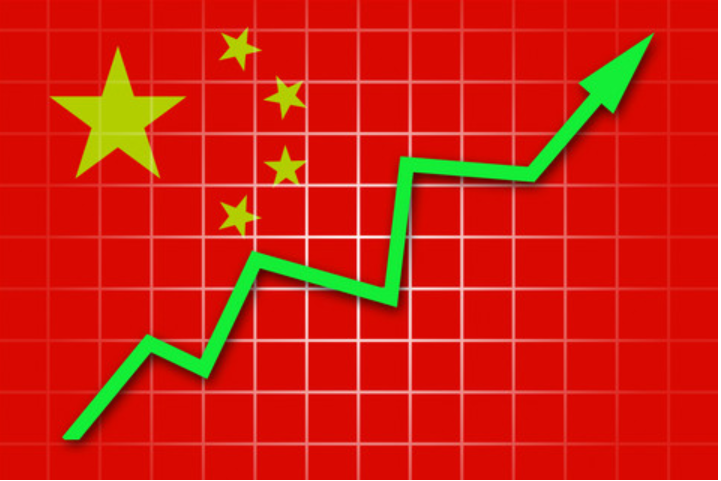Mens resten af verden var fanget af recession, havde Kina som det eneste store land en vækst i 2020 – på 2,3 pct., for hele året. Væksten blev større end ventet i 4. kvartal, på 6,5 pct. Årsagen ligger i en stærk industriproduktion og eksport. Coronaen begyndte i Kina, i Wuhan, men kineserne greb øjeblikkeligt ind mod virussen med en total lockdown og med coronatjek af alle indbyggere. Efter to-tre måneder kunne nedlukningen ophæves. Dermed har Kina været bedre i stand til at håndtere pandemien end de fleste lande, og det har styrket Kinas position i Asien og globalt. Allerede efter mindre end et år har Kina normaliseret økonomien, mens pandemien forværres i Europa og USA. Ifølge IMF fik USA et dyk på 3,6 pct. sidste år og Europa et dyk på 7,4 pct. Kinas økonomi pr. indbygger blev for første gang større end 10.000 dollar.
Uddrag fra Fidelity/Dow Jones:
China Is the Only Major Economy to Report Economic Growth for 2020
China’s economy expanded by 2.3% in 2020, roaring back from a historic contraction in the early months of the year to become the only major world economy to grow in what was a pandemic-ravaged year.
China’s ability to expand, even as the world struggled to control a deadly virus that has killed more than two million people, underscores the country’s success in largely taming the coronavirus within its borders and further cements its place as the dominant economy in Asia.
China’s growth makes it an outlier among large economies. The World Bank expects the U.S. economy to contract by 3.6% this year and the eurozone’s to shrink by 7.4% in 2020, contributing to a global economic pullback of 4.3%.
China’s economy, the world’s second largest, finished the year on a high note. Gross domestic product rose 6.5% in the fourth quarter from a year earlier, according to data released by the National Bureau of Statistics on Monday, marking China’s best quarter of year-over-year growth in two years.
By comparison, China’s GDP rose by 3.2% and 4.9% in the second and third quarters of the year, respectively, after suffering a historic 6.8% contraction in the first.
“In an extraordinary year, China’s economy was able to record an extraordinary achievement, handing over a result that satisfied the Chinese people, attracted the attention of the world and which can be written in the annals of history,” Ning Jizhe, head of the statistics bureau, said Monday.
Mr. Ning said in 2020 the size of China’s economy surpassed 100 trillion yuan, or the equivalent of $15.4 trillion, while GDP per capita topped $10,000 for the first time.
The results also beat analysts’ expectations. Economists polled by The Wall Street Journal expected growth of 6% in the fourth quarter and an expansion of 2.2% for the full year.
China’s full-year growth rate of 2.3% marked the country’s weakest annual economic expansion since Mao Zedong’s death in 1976. Before 2020, the worst economic year of China’s “reform and opening” era that began in the late 1970s came in 1990, the year after the Tiananmen Square crackdown, when the economy grew by 3.9%.
By logging 6.5% growth in the final quarter, China’s economy has reclaimed the growth trajectory that it had been on before the coronavirus first began to spread across the city of Wuhan around a year ago. In the last three months of 2019, the last full quarter before the coronavirus began disrupting the global economy, China’s GDP rose 6% from a year earlier, contributing to a 6.1% expansion for the full year.
This time last year, Chinese authorities in and around Wuhan began reporting large numbers of people who were infected with what was then a mysterious viral pneumonia. After Beijing took the unprecedented step of locking down Wuhan on Jan. 23 last year, economic activity across the country ground to a virtual halt for much of the following months until the virus was largely stamped out.
Unlike governments in Western countries like the U.S. that focused their stimulus efforts on lowering borrowing rates and handing out money to consumers, Beijing focused on restarting factories while keeping interest rates relatively higher.
China’s factories began to come back online in April, just as much of the rest of the globe’s manufacturing capacity was taken out by the spreading pandemic. That allowed China to produce and export mass quantities of medical equipment, like face masks, and work-from-home equipment, such as laptops and computer monitors.
Domestic consumption, however, continued to languish well into the summer, as Chinese consumers were worried about a resurgence in infections. Retail sales didn’t return to their pre-coronavirus levels until August and have remained relatively weak as a contributor to the overall economy as outbreaks have continued to pop up.
On Monday, China’s statistics bureau said retail sales rose by just 4.6% in December from a year earlier, lower than November’s 5% increase and a 5.5% expansion expected by economists. For the full year, retail sales fell 3.9% in 2020 from a year earlier, compared with 2019’s 8% growth.
A current wave of new cases across northern China, centered in Hebei province–which surrounds Beijing–is the worst in more than half a year, with hundreds of local infection cases showing symptoms in recent days. The outbreak threatens to derail consumer spending during next month’s long Lunar New Year holiday.
Even so, many forecasters expect China to grow by another 8% or more in 2021 as other parts of the economy continue to make up for the lost time last year. Data released Monday showed employment and wages remain robust, which could help support consumption.
China’s headline measure of joblessness, the official urban surveyed unemployment rate, held steady at 5.2% in December, on par with the pre-virus level a year earlier, according to the statistics bureau.
Migrant workers’ wages rose by 2.8% in the final three months of 2020, compared with a 2.1% increase in the previous quarter.



